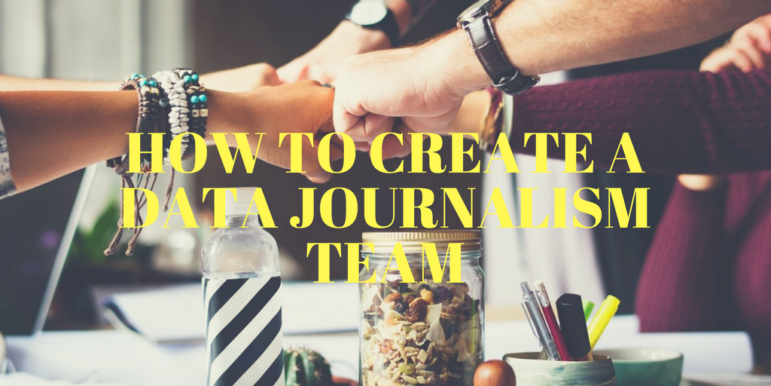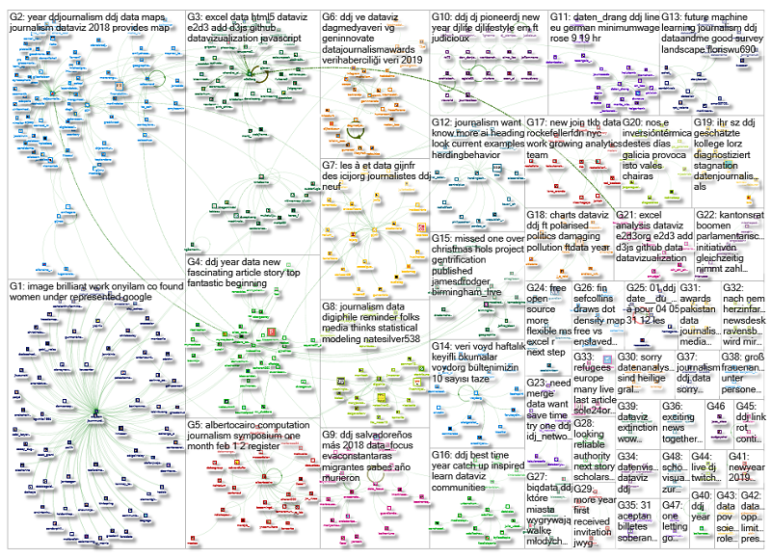

GIJN’s Data Journalism Top 10: El Salvador’s Corpses, Searching for Women, Merging Data
What’s the global data journalism community tweeting about this week? Our NodeXL #ddj mapping from December 31, 2018 to Jan 6, 2019 finds experts sharing their thoughts on machine learning in journalism with @storybench, @funkeinterativ and @webk1d‘s useful tool to merge datasets, @pewresearch‘s overview of female under-representation in online image searches, and an analysis by @EDHNoticias on corpses sent back to El Salvador.
Machine Learning in Journalism
Journalists can utilize machine learning as part of investigative reporting, or as a day-to-day tool to make repetitive tasks easier. Storybench gathered thoughts from experts in the industry about the advantages and pitfalls of using machine learning for journalism, whether it is truly necessary and the problem of algorithmic accountability.
Analyzing Dead Bodies Sent Back El Salvador
El Diario De Hoy investigated repatriation data for deceased Salvadorans. Between January 2009 and March 2018, 1,248 bodies were repatriated to El Salvador. The leading cause of death: homicide, followed by traffic accidents.
Merge Datasets with One Tool
Looking to merge datasets? Funke Interaktiv and Webkid’s Geo Data Merger tool is an open source tool which can handle json, csv, geojson and topojson files.
Searching for Women Online
The Pew Research Center used machine vision to study and analyze gender in online image search results and then compare those results with real-world gender composition data in the workforce. Researchers found that women were underrepresented in online images, when compared to their actual participation rates in majority of the jobs examined.
Data Journalism Handbook 2
Haven’t had time to read through the initial 21 chapters of the Data Journalism Handbook 2? You’re in luck, here’s a summary from AlJazeera Labs’ data journalist Mohammed Haddad, who shared 10 key takeaways from the book.
Compelling Arguments with Data
This 2017 presentation from Tableau research scientist Robert Kosara resurfaced. Here he is on the difference between storytelling and data presentation, as well as how to present data in a compelling way, with examples from the late Swedish statistician Hans Rosling.
Illustrating National Railway Delays
BBC England’s charts illustrate the problems facing Great Britain’s train network, including the causes of delays over 32 years, the influence of staff shortages and the level of passenger frustration. The code (#Python scraper and #R analysis) and analysis of the story is on github.
The Future of Data Analysis
This 2016 presentation by statistician Dr Edward Tufte has resurfaced online, thanks to Alberto Cairo. Here he is on the relationship between evidence, inference and conclusions: “Data analysis is about turning information into conclusions. Analytical thinking is about assessing and evaluating the relationship between information and conclusions.”
https://twitter.com/albertocairo/status/1080895996865990658
Computation + Data Journalism Symposium
This gathering in Miami — a celebration and synthesis of new ways to find and tell news stories with, by and about data and algorithms — is just three weeks away. The symposium will include topics such as the human touch in automated fact-checking, photomation or fauxtomation, and using algorithms to investigate algorithms and society. Register here.
Data Bulletin (in Turkish)
From interviews with data journalists to data journalism playbooks, the VOYD Veri bulletin will alert you to the latest tips and tools in the data journalism world, seen through Turkish eyes. Subscribe here.
Thanks, once again, to Marc Smith of Connected Action for gathering the links and graphing them.
 Eunice Au is GIJN’s program coordinator. Previously, she was a Malaysia correspondent for Singapore’s The Straits Times, and a journalist at the New Straits Times. She has also written for The Sun, Malaysian Today and Madam Chair.
Eunice Au is GIJN’s program coordinator. Previously, she was a Malaysia correspondent for Singapore’s The Straits Times, and a journalist at the New Straits Times. She has also written for The Sun, Malaysian Today and Madam Chair.










